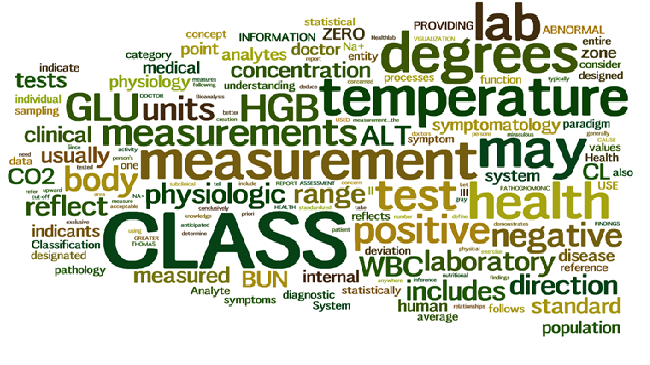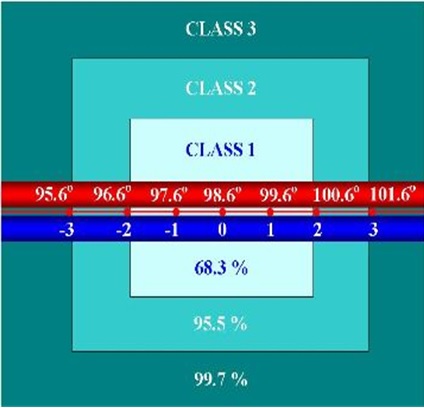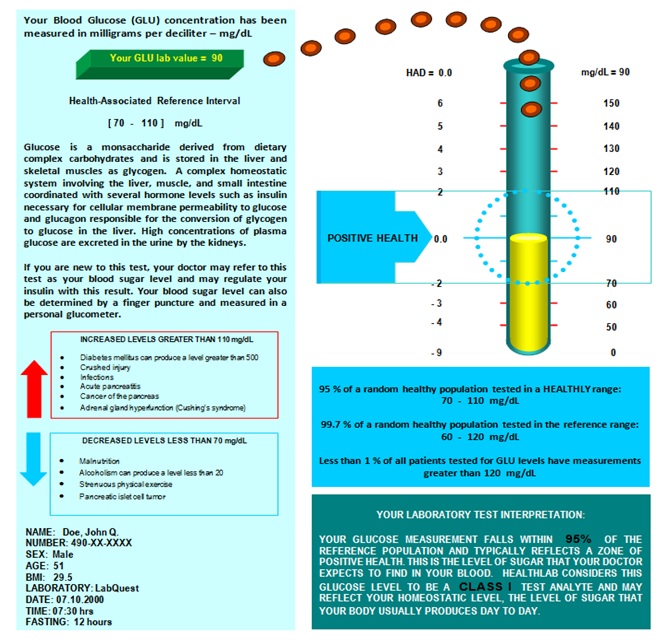A New Era for Veterans National eHealth Practice
"Seeing the Art of Medicine at the Level of Science"
- Dr. Curtis J. Tinsley, Chief Health Officer
My HealtheLab is the future of enterprise eHealth providing actionable events with visual diagnostic Dx widgets(c).
Clinical Laboratory eHealth CARE Modeling based on common linear regression:
Communication is the "ether" of 21th century healthcare
Access should be ubiqutious, the ecatheter for Veterans good health
Resources are portals or conduits for laboratory eHealth communications
Examination of lab data to control Veterans health is <sine qua non> for laboratory eHealth

About Your Health Assessment Deviation…
The Health Assessment Deviation© (HAD) is a fresh and innovative method of understanding the intricate relationship between "health" and "pathology". As it is with any miraculous creation, human physiology is an exquisite interdependent system functioning according to a designed harmony. Health almost becomes an esoteric or ontological concept when one looks deeply into the mechanism that operates the human body.
The HAD is an attempt to classify the analyte concentration (lab test) into mutually exclusive "domains" that do not conclusively define health or pathology, but establishes some reference point in order to deduce the physiologic status of the individual during nutritional processes. Simply stated, HAD values originate at ZERO and extend in a positive and negative direction until a cut-off value of 1.99, designated as CLASS I concentration or measurement. CLASS I measurements include 95% of the reference population used to determine the range of measures for the lab test. Let us consider a simple physical analogy. Because of the metabolic processes of human physiology, heat is transferred from the internal organs to the peripheral skin, where the temperature is measured.
Assume then, a priori, that 98.6 degrees ( 37 degrees Centigrade ) is the "health standard" and any deviation upward, say to 100.5 degrees constitutes a positive direction of body temperature. Employing the HAD system, 98.6 degrees is the acceptable "health standard" designated at HAD = 0 and the measurement 100.5 degrees falls within 95% of 100 persons measured for body temperature. Therefore, it follows that a measurement of 100.5 degrees is a CLASS I measurement with a HAD = 1.96, assuming a standard deviation for 100 measurements is 1.0 degrees. Hence, statistically 1.96 standardized z scores = 95% of the population measured for body temperature. The following diagram demonstrates statistical relationships between measurement, HAD and statistical inference.

Figure: The Health Assessment Deviation Dx Classification Schema for Temperature
Figure HAD. Demonstrates statistically the range of temperatures common to body temperature you may have measured. The concern of "temperature" is generally acknowledged as a shift of 1.5 degrees or more in body temperature. Temperature is a very important clinical measurement for doctors because it presents a clue to the internal function of your organ systems. Most physicians would consider the measurement of 101.6 degrees as a "fever" and would immediately be alerted of a natural internal physiologic process. The temperature of 101.6 degrees would be considered a CLASS 3 temperature and medical action could be needed for this finding. Healthlab – Uniquely Personal Health through Preventive Care. 1985. Health Laboratory Research Institute, 1985.
About your Analyte Classification System of Measurements...
The Analyte Concentration Classification System© (ACCS) is a concept that effectively and efficiently assimilates the empirical data produced by the clinical laboratory. The classification system can be further expanded to reflect a symptom category. Since the activity of the clinical laboratory is to measure your subclinical findings via bioanalysis, the numeric data (lab test) can be translated to a symptom category as follows:
CLASS I: HAD positive and negative direction from 0 to 1.99
CLASS I analytes or lab tests may reflect FUNCTIONAL physiologic symptomatology. These are the usual indicants observed in "stable-state physiology" or homeostasis. Functional symptoms may also be expressed in the presence of a known disease entity. CLASS I measurement is the anticipated concentration in nondiseased subjects and includes 95.5% of a sampling or diagnostic paradigm that usually reflects a zone of POSITIVE health. HAD range includes ZERO ( average person's test measurement...the same as calling 98.6° standard temperature ) plus or minus 1.99 units around the average or ZERO in the population tested. Your doctor will usually tell you that your lab test is NORMAL.
CLASS II: HAD positive and negative direction from HAD 2.0 to 2.99
CLASS II analytes or lab tests may reflect EQUIVOCAL physiologic symptomatology. These indicants may not point to any special disease entity, being associated with any one of a number of morbid states. This CLASS of measurements may also indicate a health/disease overlap referred to as PHYSIOLOGIC OVERLAP or may be due to individual variation or indicative of a prodromal effect ( before symptoms manifest ) and includes 99.7% of a sampling or diagnostic paradigm that usually reflects a zone of CAUTIOUS health. HAD range includes positive 2.0 units to 2.99 units and negative 2.0 units to 2.99 units. This is a narrow CLASS of measurement and your doctor may refer to this type of lab result as a BORDERLINE or GRAY AREA.
CLASS III: HAD positive & negative direction from 3.0 to clinical absurdity.
CLASS III analytes or lab tests may reflect PATHOGNOMONIC symptomatology.
These indicants usually point unmistakably to certain disease entities. If there are no medical operatives such as drugs, exercise, or genetics, then these measurements indicate decreased health unless a desirably elevated concentration is beneficial to physiologic function and may reflect a zone of NEGATIVE health. HAD range includes any measurement GREATER THAN positive +3.0 or negative ─3.0 units. Your doctor is most concerned with this CLASS of measurements because this group of measurements represents less than 0.3% of all test values and typically tells you that your lab tests are ABNORMAL HIGH or ABNORMAL LOW… Your doctor will usually tell you that your lab test is ABNORMAL.

Figure: Patient Glucose Report for My HealtheLab visually illustrating the "normal" blood glucose report with instructions for your health.
NOTE WELL: THE SOLE PURPOSE FOR PROVIDING THE HEALTH ASSESSMENT DEVIATION IS TO AUGMENT THE VISUALIZATION OF THE NUMERICAL FINDINGS REPORTED IN YOUR LABORATORY REPORT. THE HAD CLASSIFICATION IS NOT A DIAGNOSIS, BUT A TOOL TO BE USED BY YOUR ATTENDING PHYSICIAN. NUTRITIONAL EVALUATION OF YOUR PHYSIOLOGY IS THE PRIMARY INTENT OF PROVIDING THIS INFORMATION FOR YOUR PERSONAL USE. USE IT WISELY; CONSULT YOUR DOCTOR IF ANY INFORMATION MAY CAUSE YOU CONCERN OR CONFUSION. REMEMBER WHAT THOMAS EDISON TOLD US… The doctor of the future will give no medicine but will interest his patients in the care of the human frame, in diet, and in the cause and prevention of disease.